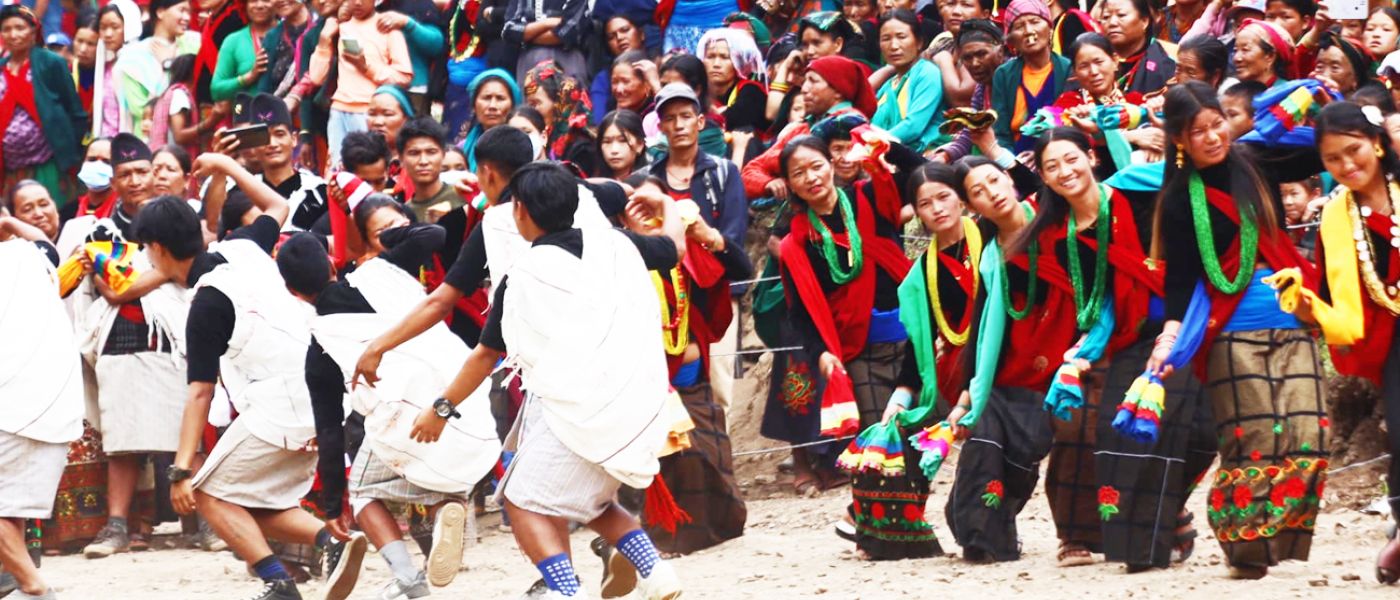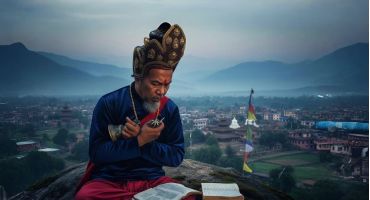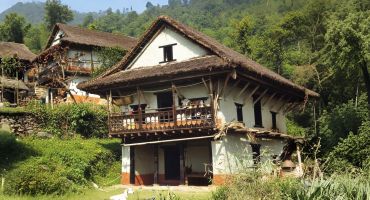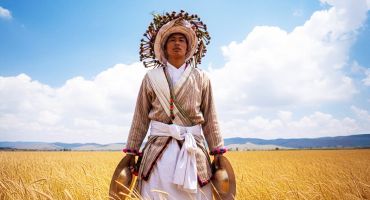Social cluster, based on tribal affinity or kinship or, occasionally, on geographical contiguity, ensures the continued observance of social and religious customs and ceremonies within the community. Through the passage of countless centuries, the Himalayan tribes have weathered the ages, weaving intricate social clusters that exist in harmony with the tapestry of their cultural traditions. These clusters, like the Bheja system of the Magars, have played a significant role in the preservation of the tangible and intangible aspects of Magar culture. Bheja, a communal congregational group, holds the responsibility of overseeing various functions within the tribe. Despite being of independently Magar origin, it assumes the religious operations of the Guthi of the Newars, the economic functions of Dhikuri of the Thakalis, and the Kipat communal land tenure system of the Kiratis. The origin of the word Bheja comes from ‘bhai’ and ‘jaa’, meaning ‘brother’ and ‘descendant’ in the Magar language, and is a significant facet of traditional Magar culture.
Much like the norm within traditional scenarios, social clusters inherently involve a temporary relinquishment of personal rights to the collective, standing in stark contrast to the established norms of ordinary times. This encompasses economic behaviors, ritualistic choices, communal resource sharing, and even the inversion of societal roles. Such social clusters are vital in rural areas in keeping with social, economic, and cultural traditions. In the case of Bheja, while it is considered neither voluntary nor forced, it exists as a reminder of the connection between indigenous peoples to their lands and the traditions attached to it. It is a part of the customs of communal bonding that have existed for hundreds of years, preceding the creation of proper tribal groups, taking advantage of different climates, and harvesting periods, and allowing communities to perform cultural rites and participate in social interactions with other groups. A single community cluster can contain multiple Bhejas, and each Bheja may span across multiple clusters. The size of a Bheja can vary depending on the size of the cluster and any geographical or other differences. Every household within the cluster is expected to be a member of the Bheja, without any specific criteria.

Originally, Bheja was a camp or settlement of related families under a headman/chief and functioned in the past as a social and political unit. A strong sense of family that functions horizontally as well as vertically is a characteristic of the Magar community. Today, an elderly and respected male member of the community serves as the chief or Mukhiya. In its most general sense, Bheja consists of all those relatively stable features of a social system, which an acting unit would be prudent to take into account if it wishes to make rational decisions regarding the community as a single entity. Even though the Mukhiya assumes the role of chairing meetings and holds a vital position in decision-making, their authority does not vary significantly from that of other members. It is expected that a Mukhiya chair all meetings, contribute suggestions, and occasionally delegate specific tasks to fellow members. However, he does not enjoy exceptional privileges.
Certain Bhejas have the power to include individuals who are not Magars within the same or neighbouring cluster. However, their participation within the Bheja is considerably restricted compared to that of the Magars. Consequently, invited members are unable to hold positions such as Mukhiya or Wappa/Bhusal (ritual priest of officiant). While social stratification typically implies the establishment of hierarchical positions within a society, distinguishing between superior and inferior ranks, the Magar culture places greater emphasis on Magar kinship while also embracing inclusivity within a contemporary multicultural context.
Bheja as a religious gathering
Bheja also arranges group worship ceremonies to venerate indigenous gods and ancestral spirits, encompassing an annual schedule of five distinct worship rituals.
During the final month of each year, a special event known as Susupak Bheja takes place, resembling a collective gathering for the entire community. Every household considers this occasion highly significant. It is during this period that new rules and regulations are formulated, modified, or reviewed. Within the economic framework of the community, decisions are reached concerning wages, the prices of essential goods like vegetables and meat, as well as other fundamental necessities. Vital matters are deliberated upon and settled for the upcoming year, including the potential selection of a new Mukhiya if needed. As a result, this event is referred to as “riti-thiti basalne Bheja,” signifying the establishment of norms. In certain regions, it is also known as Chandi Bheja. This particular period serves as an extensive discussion platform for village responsibilities, aspirations, and guidelines. A central focus of this event involves discarding obsolete customs and traditions in favor of embracing new ones.
Nwagi Bheja is observed prior to the commencement of the sowing season. During this period, the deities believed to influence a prosperous harvest are venerated. Collective worship ceremonies take place, and the community comes together to seek a favorable season, free from adversities and unforeseen natural events. Mangsire Bheja takes place in the month of Mangsir (November-December). This ritualistic observance, known as Bheja worship, is a way of honoring Thekani Mai, a revered female deity. The local community believes that Thekani Mai safeguards the villagers from illnesses. Similarly, Jethebheja involves the reverence of Firante Mai, a peripatetic divine feminine spirit. This ceremony occurs in the month of Jestha (May-June). On the other hand, Chaitebheja is a ritual performed to avert natural disasters connected to the earth, specifically focusing on soil-related calamities.

Social Functions of Bheja
Bheja consists of a wide variety of family groups, village houses, and institutional organizations that reflect community life. All decisions related to the benefit of a social group regarding religious activities, social, and agricultural celebrations are taken at the Bheja meetings.
Interestingly, these ceremonies do not necessitate designated temples or specific shrines for deities. The location for the rituals is determined by the Bheja itself. Typically, they choose hilltops in proximity to forests where activities such as timber cutting and livestock grazing are prohibited. This practice stems from the belief that naturally sacred and undisturbed places should be chosen. Consequently, the areas surrounding these sites retain their lush greenery. This aspect of their belief system has taken on a somewhat “conservationist hue,” representing a form of ecological adaptation. As part of appeasing the spirits, offerings of pigs, male buffaloes, goats, and jungle fowls are considered essential and are sacrificed during these ceremonies.
Agriculture and Bheja
Another culturally noteworthy practice within the Magar community involves a specific day when individuals abstain from engaging in activities beyond their homes. The exact date of this day varies across locations and groups, contingent on the guidance of Bheja. In the past, this day carried restrictions on the entry of outsiders into the village and the departure of villagers from it. Those who transgressed this custom would be subject to penalties. During this day, the Mukhiya offers a prayer to Bhume (the earth) through a ceremony known as Main Dhare.
While agriculture constitutes the primary occupation of the Magar people, Bheja encourages the practice of Parima, a system based on the reciprocal exchange of labor. Additionally, temporary labor collectives known as Bhaijeri come into play at times. Bheja oversees these transient labor groups, and instead of wages, they receive recompense in the form of two meals and beverages.
Bheja holds a crucial role in determining the schedule of fieldwork, guaranteeing that all households have the opportunity to efficiently accomplish their tasks in accordance with their requirements. Although Bheja’s initial purpose did not pertain to agricultural labor, it has now acquired the authority to establish and even modify labor wages. This strategy mitigates labor shortages among the Magars, especially during the most demanding phases of the farming seasons.
Across the various tribes inhabiting the Himalayan region, the social structure exhibits diversity influenced by group dynamics, objectives, and geographical placement. Tribal communities encompass a broad spectrum of family units, rural arrangements, and institutional structures that manifest in the fabric of community life. Consequently, the notion of social clusters, such as Bheja, serves as an analytical construct that amalgamates diverse forms of individual and collective conduct. Its purpose lies in uniting either an individual with a group or linking various members within a group. While contemporary society champions personal independence, within a clan system, greater emphasis is placed on shared accountability. Traditional teachings emphasize the pursuit of coexisting harmoniously with oneself, one’s family, the broader community, and even the natural world. Thus, within the framework of the Magar Bheja system, individuals are tasked with perpetuating these cultural teachings through their way of life.





Leave a Reply